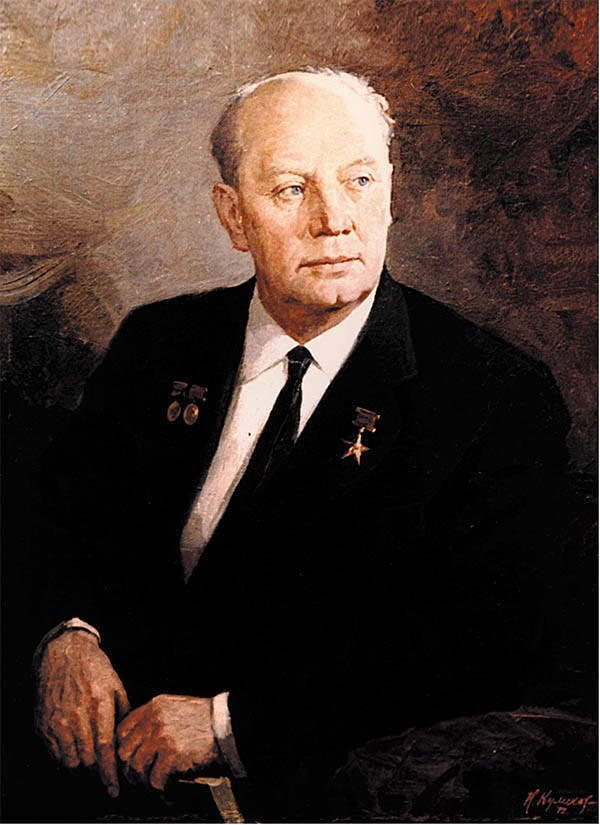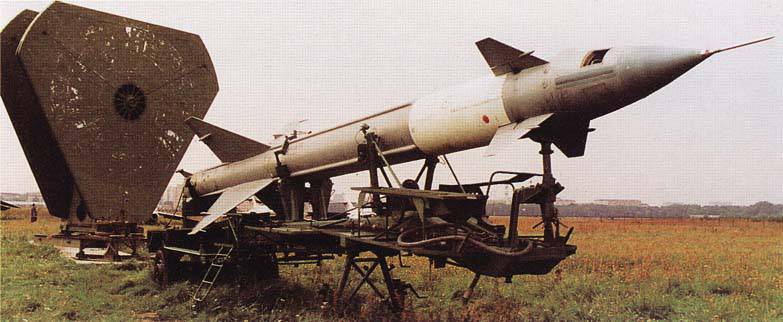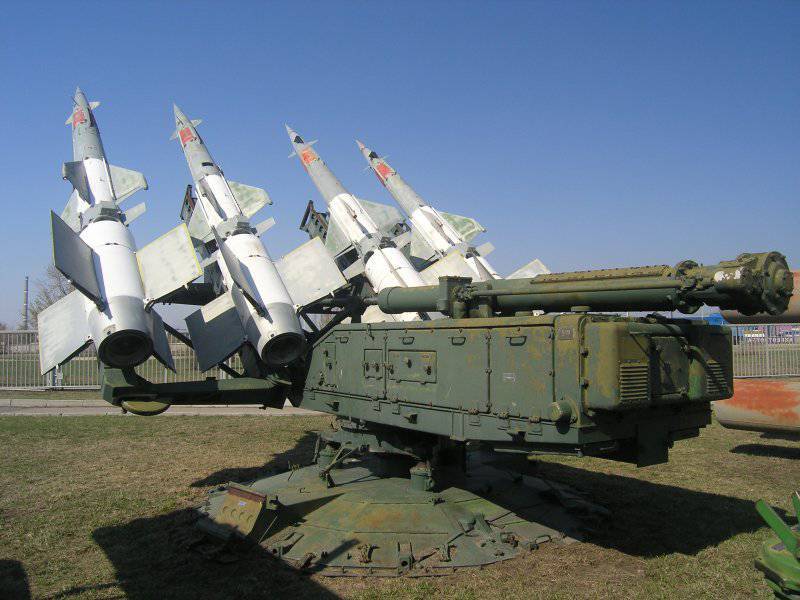Era Alexander Raspletin

The massive use of aircraft during the Second World War showed the insufficient effectiveness of existing air defense systems, including fighter Aviation and anti-aircraft artillery. Work on the creation of the first Soviet anti-aircraft missile system was begun in the postwar years on the basis of research on German missiles: Typhoon, Reintochter, Schmetterling and others. The main attention of specialists from NII-88 was focused on the world's first anti-aircraft guided missile "Wasserfall", which after a number of improvements received the code number R-101. A series of tests was carried out, but the country's leadership at that time was still not well aware of the importance of such work. The main resources were redirected to the study of long-range ballistic missiles, and work on the modernization of the captured rocket was discontinued. However, the equipment of nuclear bombers weapons and the escalation of the Cold War in the early fifties created a real threat of air strikes against the objects of our homeland. To protect the country, a fundamentally new type of weapon was required. Under these circumstances, Joseph Stalin was tasked with creating an advanced, completely impenetrable anti-aircraft defense of Moscow. During the discussion, it was decided to develop and build the largest at the time anti-aircraft missile complex for the defense of the capital, which could repel a massive raid involving more than one thousand enemy aircraft. For the speedy creation of this system, emergency measures were taken.
To manage all the work under the Council of Ministers of the USSR, the Third Main Directorate of the DSU was created, which was subordinate to the all-powerful at that time, Lavrenti Beria. In 1950, under absolute secrecy, a powerful head design bureau was formed, history called KB-1. Leading scientists and specialists of the country, as well as whole crowds of graduates of civil and military universities were transferred to its structure. Dozens of design and design enterprises were connected to the works, at the same time having organized a wide cooperation of factories for mass production of the necessary means for the system. In the lower reaches of the Volga, the construction of the Kapustin Yar anti-aircraft testing range began.
The chief designers of the system, which received the code designation "Golden Eagle", were appointed: radio engineering specialist Kuksenko Pavel Nikolaevich, even before the war, became known as an outstanding design designer and son of Lavrenti Beria - Sergey Beria, who had just graduated from the Military Academy of Communications. Alexander Andreyevich Raspletin was appointed Deputy Chief Designer and Head of the Radar Division of KB-1.
Alexander Raspletin 23 was born on August 1908 in a merchant family in the Volga city of Rybinsk. His father died when the boy was only ten years old. At school, Raspletin became interested in the radio business, entered, and soon headed the local radio circle. When Alexander grew up, he was accepted into the Bureau of the Society of Radio Amateurs Rybinsk. After graduation, he went to work as a fireman - it was necessary to somehow feed the family, and there was no other work. At the first opportunity, Raspletin managed to get a job as a radio mechanic to continue doing his favorite job. In Rybinsk, he carried out the first design development - personally created a shortwave transmitter. In order to further professional growth in the 1930 year, Raspletin changed his place of residence, moving to Leningrad, where he began working as a mechanic at a radio factory. After the change in the enterprise, he studied at the evening department at the Electrotechnical Institute. In 1932, he was included in the group that develops the first domestic televisions, where he successfully worked as an engineer, and soon after graduating from the institute he became the head of the group. With the direct participation of Alexander Andreevich, the first domestic television receivers were created before the war.
When the Great Patriotic War began, Raspletin was involved in the defense theme, and his efforts created military radio stations. During the blockade in Leningrad, he lost his mother and wife. Alexander Andreyevich himself, barely alive, suffering from dystrophy, in the winter of 1942, was evacuated to Krasnoyarsk.
In 1943, the Central Radiolocation Research Institute was founded in Moscow, to which the country's best specialists were sent. Raspletin was assigned to this institution. The years of Raspletin's work at the Central Research Institute were very fruitful: in seven years he created four models of fundamentally new radio engineering devices for military use. For the development of the SNAR - a radar ground artillery reconnaissance station - Alexander Andreevich and his closest employees were awarded the Stalin Prize. A small part of the received reward was spent by a scientist on the purchase of a car, and for the remaining money he organized a banquet for all the staff of the institute. Here in the Central Scientific Research Institute in the 1947 year, Raspletin successfully defended his thesis and entered the Academic Council.
In the 1950 year, after Raspletin moved to KB-1, he was entrusted with a highly responsible task for choosing the structure of the Moscow defense system, as well as designing its radar equipment. In the shortest possible time, he developed a solution that was far ahead of his time. The radar created by Raspletin for the first time in world practice was multifunctional. He provided not only the detection and tracking of up to twenty targets, but also the simultaneous guidance of missiles at them. For the defense of Moscow, it was necessary to install fifty six such devices. When using the existing locators, they would need more than a thousand. The design of the system’s facilities proceeded at such a high rate that test launches of missiles at the test site were launched two years later.
As a result of successful tests at the 26 test site on April 1953, for the first time in history, the strategic military bomber TU-4, converted into a radio-controlled target aircraft, was shot down with an anti-aircraft missile system. On this day, a completely new type of weapon was born.
This system was named C-25, and Alexander Raspletin, shortly after the arrest of Lawrence Beria, was appointed chief designer. In May, the 1955 of the C-25 anti-aircraft missile system was put into service and put on alert. It was so successful that for more than three decades it surpassed all foreign analogues. For the development of the system, Raspletin was awarded the degree of Doctor of Technical Sciences, as well as the high title of Hero of Socialist Labor.

For the further development of the air defense of our country with its vast expanses, complexes of a completely different class were needed - mobile and mobile. And Alexander Andreevich took up the creation of such systems. The first of these was named C-75. Raspletin appointed his deputy, Boris Vasilyevich Bunkin, to lead the work on the creation of radar equipment of this complex, and Pyotr Dmitrievich Grushin became the chief designer of the rocket. All means of the system were placed in transported cabins and trailers and could be deployed in six hours. In total, three modifications of the system were created, the last of which, the three-cabin version, was produced in large series. The C-75 system had very high performance and exceeded all foreign counterparts of that time. It has become the main air defense weapon, the shield and sword of our Motherland. It was widely used in the Air Defense Forces, in the Army, installed on ships. C-75 bought dozens of friendly states to us. And in any climatic conditions - in hot deserts, tropical jungles, in the far North - the system demonstrated high reliability and efficiency.
In 1964, the Americans launched a war against North Vietnam and, without meeting resistance, literally bombarded the country. In order to provide friendly assistance, mobile C-75 systems were supplied to Vietnam and the situation changed dramatically. During the years of the Vietnam War, several thousand American aircraft were destroyed by the Soviet complexes, including several dozen of the highly praised B-52 strategic bombers. The Vietnam War, as you know, was lost by the Americans. A huge role in the victory was played by the anti-aircraft missile complex C-75, bringing fame to its creators headed by Alexander Andreyevich Raspletin.
Almost simultaneously with the C-75, Raspletin begins work on an anti-aircraft missile system designed to combat low-flying targets, known as the C-125. How this system originated, recalls the famous pilot Georgy Filippovich Baidukov, who was at that time the head of the Main Directorate of the Ministry of Defense in charge of air defense weapons orders: but also at a height of twelve meters and above the forest. Speeds are also growing and you just need to have a weapon against low-flying targets. We talked a lot about such a protective complex. I, as a former pilot, insisted that such a system should operate from a twenty-meter height for a decent range. Initially, the anti-aircraft missile complex was designed, operating at a five-hundred-meter height and fifty kilometers in range, but when they began to work on it, it turned out that even lower altitude was fifty meters. And so C-125 appeared. ”
The C-125 mobile system was located in cabs and trailers and could destroy aerial targets flying from any direction. It was also supplied to many countries of the world and, in particular, was used in the Arab-Israeli conflict. Both C-75 and C-125 complexes were in service with domestic air defense forces for more than thirty years, while maintaining high efficiency in combating modern and promising targets.
To combat aircraft, carriers of cruise missiles, in the sixties, under the leadership of Alexander Raspletin, a great deal of work was carried out on designing a new anti-aircraft missile complex C-200. This system ensured the destruction of aircraft at long ranges to the line of discharge of cruise missiles. In C-200, fundamentally new technical solutions were implemented that were not used anywhere else. For the first time a semi-active homing head was used on board an anti-aircraft missile. The system is also versatile and provides for the destruction at long ranges and heights of any types of manned aircraft, and also effectively strikes small-sized unmanned targets in a wide area. Many characteristics of this complex are still unsurpassed.
In the 1966 year, Alexander Raspletin made a proposal to create a multi-channel mobile anti-aircraft missile system, uniform for all types of armed forces, based on the latest advances in radar and missile technology. A unique, formidable C-300 came to replace the previously created complexes, which ensured the destruction of any existing active aerodynamic targets, including all types of cruise missiles flying at high, low and even extremely low altitudes. At the same time, she could hit up to six goals. The deployment time from the march was only five minutes. In terms of a number of basic characteristics, this anti-aircraft missile system exceeded the American Petrium system of a similar class. The development of the C-300 complex, after the death of Alexander Andreevich, was completed by his successor, twice Hero of Socialist Labor, Laureate of the Lenin and State Prizes, academician Boris V. Bunkin. The missiles for the system were developed under the direction of Pyotr Dmitrievich Grushin.
After the death of the great scientist, the government established the Prize of the Russian Academy of Sciences named after him, which is now awarded for outstanding developments in the field of radio control systems.
Alexander Andreevich all his life remained a very modest man. He had a small cottage near Moscow, where he loved to spend the weekend. Much there is done by his hands. The story has retained unacceptably few documentary shots about the life of this man - just one amateur film, and a few photos. He had almost no free time. And in the military and in the postwar years, work has always been the main thing for him. Alexander Andreevich worked without holidays, but in communication he always remained a cheerful and cheerful person. With his energy and spontaneity, he could easily captivate everyone who was near him. Raspletin turned even a collection of mushrooms that grew everywhere in the dacha of a scientist into a fun game. Bypassing the territory in advance, he left notes with points from the mushrooms found. The one who scored the most points received memorable souvenirs from him. Raspletin was also passionately fond of fishing, and even in the last days of his life he asked me to bring Kotlyarskaya fish soup to the hospital. He liked funny jokes, he was always a welcome guest in the pioneer camp of his company, he loved to communicate with young people, seeing in it the future of our country.
Raspletin enjoyed enormous prestige among the staff of the team. Well versed in people, he found a place for everyone according to his talent and level of training. He knew how to ignite subordinates, noticed and supported any creative find. I mistook for failures, but it is not insulting, without humiliating human dignity.
Alexander Andreevich died in the prime of his creative powers when he was just 59 years old. He was buried in Moscow at the Novodevichy cemetery. In honor of the designer, a crater was named on the back side of the moon, his name is carried by GSKB Concern Air Defense "Almaz-Antey", the streets in Moscow and Rybinsk. But the main monument to Alexander Andreyevich is the armament complexes he created, which ensured reliable protection of the air borders of our Motherland. The creation and introduction into production of each of these systems raised our science and industry to a higher scientific and technical level. There are people who predetermined with their bright creative life and labor achievements the direction in the development of not only work collectives, but also entire branches of production. Alexander Andreevich Raspletin, undoubtedly, is one of the brilliant diamonds in the pleiad of the most talented scientists of our great country.
Information sources:
-http: //old.raspletin.ru/company/persones/raspletin/biografy.aspx
-http: //army.lv/en/A.-A.-Raspletin-osnovatel-rossiyskih-sistem-upravlyaemogo-raketnogo-oruzhiya/2668/4740
-http: //old.vko.ru/article.asp? pr_sign = archive.2001.1.0101_09
-http: //ru.wikipedia.org/wiki/

Information